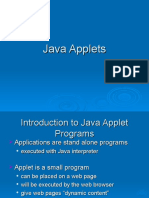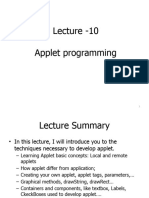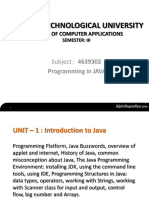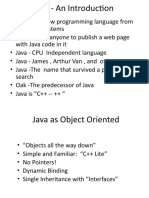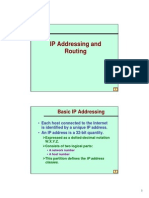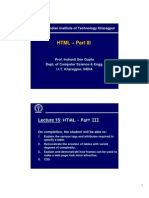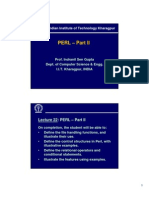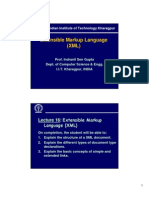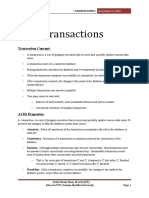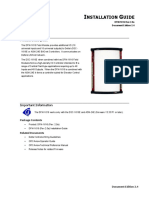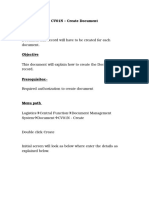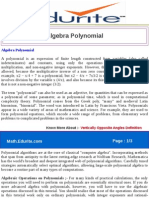Indian Institute of Technology Kharagpur
Java Applets – Part I
Prof. Indranil Sen Gupta
Dept. of Computer Science & Engg.
I.I.T. Kharagpur, INDIA
Lecture 28: Java applets – Part I
On completion, the student will be able to:
1. Explain the main design goals of java.
2. Justify why java is considered by many to be a
language suited to be used in the Internet.
3. Explain the basic concept of a java applet, and how
it is different from a java application.
4. Illustrate how an applet can be embedded in a HTML
document.
5. Demonstrate the execution of simple applets.
1
� Introduction
• The language Java originated at SUN
Microsystems.
¾By a small group of people who were trying
to develop a new object-oriented language
that would be suitable for consumer
applications.
• Java is a fully object-oriented language.
• It is easier to write bug-free code in java
than C++.
• Some bug-savvy features of C++ were
eliminated:
¾No manual memory allocation/deallocation.
¾No pointer arithmetic.
¾No multiple inheritance.
¾No operator overloading.
¾No #define and typedef.
2
� Design Goals of Java
• In a published white paper, the following
design goals were stated.
¾Java is simple.
¾Java is object-oriented.
¾Java is distributed.
¾Java is robust.
¾Java is secure.
¾Java is architecture neutral.
¾Java is portable.
¾Java is interpreted.
¾Java is simple
It is basically a cleaned up version of C++.
Omits many rarely used and confusing features
of C++.
The size of the basic Java runtime is under 200
Kbytes.
¾Java is object-oriented
Features comparable with that of C++.
¾Java is distributed
Comes with extensive class libraries for
handling standard TCP/IP based applications.
Easy to write client-server applications.
3
�¾Java is robust
Java compiler detects many errors that would
possibly show up only at run time in some
other languages.
Use of pointers is safe; we can never access a
bad pointer or make memory allocation errors.
¾Java is secure
The Java runtime disallows a number of things
(to be discussed later) that may pose security
threats.
¾Java is architecture neutral
Because of the fact that Java compilers
generate byte code, which gets executed by
Java runtime.
¾Java is portable
Java requires the sizes of primitive data to be
specified.
Binary data are stored in a fixed format,
thereby avoiding the Big Endian / Little Endian
confusion.
Strings are stored in Unicode format.
4
� ¾Java is interpreted
The Java runtime (interpreter) can run on any
machine / environment where it has been
ported.
The Java runtime is not platform independent;
we need to have one for every possible
environment.
Existence of the Java runtime makes Java
byte code platform independent.
Platform Independence
• Java solves this problem using the concept
of Java Virtual Machine (JVM).
¾JVM provides a virtual CPU and a virtual
instruction set (called byte code).
¾The Java compiler transforms a Java
source program into byte code.
¾A Java interpreter (called Java Runtime)
converts the byte code instructions to
native processor instructions and executes
them.
Specific to environment and OS.
5
� Java Source Program
Java
Compiler
Java Byte Code
Java Runtime Java Runtime Java Runtime
for for for ....
Windows/XP Linux SUN Solaris
Java and the Internet
• Java is considered to be a language
well-suited to be used in the Internet.
¾In contrast with Java applications, there is
something called Java applets.
Applets can be embedded within a HTML page.
Applets exist in byte code form on the server.
Applets are downloaded by the browser and
executed on the client machine.
¾Since applets run (interpreted) on the client
machine, response is much better as
compared to a remote CGI script.
6
�• A Java applet can be embedded
within a HTML document using the
<APPLET> tag.
<APPLET CODE=example.class
WIDTH=300 HEIGHT=250>
<PARAM …………>
</APPLET>
Why do we need Applets?
• The language Java is very convenient
for:
¾Programming involving graphics.
¾Interactive applications.
¾Network programming, etc.
• We need applets because:
¾They allow Java programs to be
downloaded and run on the browsers
themselves.
¾Attractive / interactive web pages.
7
�• Web based applications:
¾A client computer can just have the JVM.
¾Users can download and use whatever
programs/utilities they need.
A word processor.
An email client.
Game programs.
Only limited by imagination ……
• The language C# is considered as an
alternative to Java for developing Internet
applications.
Security Issues
• Applets are downloaded from a remote server
and executed on the local machine.
• Following restrictions normally apply:
¾They cannot invoke any local executable.
¾They cannot access the local file system.
¾They can communicate with only the web
server from where they were downloaded,
and not with any other host.
¾They cannot access sensitive information
on the local host, like user’s name, email
address, etc.
8
�• Not possible to have malicious code in
Java applets.
¾ Considered to be a plus point of Java.
¾ Other alternatives are not considered to be as
safe.
A malicious ASP code, for instance, can
access sensitive information from the local
file system.
Java Applications / Applets
• Java applications are stand-alone
programs like any native program.
¾Compiled as:
javac exampla.java
¾Executed as:
java example.class
¾The bytecode example.class is portable.
9
� ¾A simple Java application:
// A rudimentary Java application
class example
{
public static void main (String args[ ])
{
System.out.println (“Thank you \n”);
}
}
• In contrast, a Java applet is meant to be
run from within a browser or using a
special utility like the appletviewer.
¾Does not have a main() method.
¾Must have a HTML file from where it is
linked.
¾Executed (using appletviewer) as:
appletviewer example.html
10
�¾A simple Java applet:
// A rudimentary Java applet
import java.awt.Graphics;
import java.applet.Applet;
public class example1 extends Applet
{
public void paint (Graphics g)
{
g.drawString (“Good Day!”, 50,10);
}
}
¾The corresponding HTML file:
<HTML>
<APPLET CODE=example1.class,
WIDTH=150,
HEIGHT=150>
</APPLET>
………
………
</HTML>
11
� The <APPLET> Tag
• General syntax:
<APPLET CODE = applet class file
WIDTH = pixels
HEIGHT = pixels
[CODEBASE = directory to look for]
[ALT = alternate text]
[NAME = name of current applet instance]
[ALIGN = applet alignment]
[VSPACE = pixels]
[HSPACE = pixels]>
[<PARAM NAME = par. name VALUE = par. value>
…….
…….
<PARAM NAME = par. name VALUE = par. value>]
[HTML to be displayed in the absence of java]
</APPLET>
12
�• The attributes:
¾ CODE: Specifies the name of the applet class file
(no subdirectories allowed).
¾ CODEBASE: Specifies a subdirectory where the
applet is to be found.
In general, can be a URL pointing to any web
server.
¾ ALT: Specifies a text message which is displayed
if the browser understands the <APPLET> tag but
cannot run the applet due to some reason.
¾ WIDTH, HEIGHT: Specify the size of the applet
display area in pixels.
¾ NAME: Specifies a name for the current applet
instance.
Required when two applets on the same HTML
page wants to communicate with each other.
To access an Applet subclass Applet_A named
“one” from anothet applet, we use:
Applet_A p = getAppletContext().getApplet (“one”);
Methods of Applet_A can now be invoked using
the pointer p.
¾ ALIGN: Specifies the alignment of the applet
(LEFT, RIGHT, etc.).
13
�¾ VSPACE, HSPACE: Specify in pixels the margin to
be left in the vertical and horizontal directions for
the applet.
¾ PARAM, VALUE: Used to pass parameters to an
applet from the HTML page.
<APPLET CODE = “Exam.class” WIDTH=100 HEIGHT=100
<PARAM NAME = s_name VALUE = “Tarun Mitra”>
<PARAM NAME = rollno VALUE = “99213”>
<PARAM NAME = colorblind VALUE = false>
</APPLET>
String name = getParameter (“s_name”);
int roll = Integer.parseInt (getParameter (“rollno”));
boolean cb = Boolean.valueOf
(getParameter (“colorblind”));
14
� Some Applet Examples
Example 1: draw lines
import java.awt.*;
import java.awt.Graphics;
import java.applet.*;
public class DrawLines extends Applet
{
public void paint (Graphics g)
{
for (int i = 10; i < 300; i += 10) {
int x1 = 300-i; int y1 = 290;
int x2 = 290 ; int y2 = i;
g.drawLine ( x1,y1, x2,y2 );
} } }
15
� Example 2: play a sound clip
import java.applet.*;
import java.awt.*;
import java.net.*;
public class PlaySound extends Applet
{
public void init()
{
URL sound;
try {
sound = new URL ("http://iitkgp.ac.in/anthem.wav");
}
catch (MalformedURLException e) {
return;
}
play (sound);
} }
Example 3 : display image
import java.applet.*;
import java.awt.*;
import java.awt.image.*;
import java.net.*;
public class SampleGif extends Applet
{
Image picture = null;
public void init() {
URL url;
try { url = new URL("http://iitkgp.ac.in/logo.gif"); }
catch (MalformedURLException e) { return; }
picture = getImage (url);
}
16
� public boolean imageUpdate (
Image img, int infoflags,
int x, int y,
int width, int height )
{
paint (getGraphics() );
return true;
}
public void paint( Graphics g )
{
if (pic != null) {
g.drawImage (picture, 0, 0, this);
}
}
}
17
� SOLUTIONS TO QUIZ
QUESTIONS ON
LECTURE 27
Quiz Solutions on Lecture 27
1. How do you store and retrieve the value of
a cookie?
Example:
document.cookie = “mod_date=” +
escape (document.lastModified);
2. How do you access a Java applet from
Javascript code?
The applet created by an <APPLET> tag with a
NAME attribute of “myapplet” can be referred to as
document.myapplet
18
� Quiz Solutions on Lecture 27
3. What do the “window” and “document”
objects represent?
The “document” object represents the
HTML document.
The “window” object represents the
window (or frame) where the
document is being displayed.
Quiz Solutions on Lecture 27
4. How do you change the background and
foreground colors of a document?
By setting the properties document.bgColor
and document.fgColor of the document
object.
19
� QUIZ QUESTIONS ON
LECTURE 28
Quiz Questions on Lecture 28
1. Why is Java considered to be secure?
2. What makes Java programs platform
independent?
3. What is the difference between Java byte
code and Java run time?
4. What is the difference between a Java
application and a Java applet?
5. How can you pass parameters to an applet
from the HTML page?
6. Is it possible to invoke a method of some
other applet from another applet on the same
HTML page?
20






